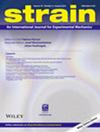使用数字图像相关技术测量现役12% Cr钢在非均匀应力场中的蠕变变形
IF 2.4
3区 材料科学
Q2 MATERIALS SCIENCE, CHARACTERIZATION & TESTING
引用次数: 3
摘要
材料的劣化评估对于火电厂关键部件的持续有效运行至关重要。确定在高温和应力下运行的电力工程合金的蠕变损耗程度,指导维护策略,以确保工厂可靠运行。在渐进式检验理念中,由于加工标准试样几何形状的材料可用性有限,传统的基于实验室的蠕变测试通常很难对退役钢进行。这项工作研究了一种通过数字图像相关(DIC)测量多个应力和600°C下蠕变应变曲线的技术,该技术使用非传统的试样几何形状和全场应变测量。令人感兴趣的是退役X20CrMoV12‐1(X20),它广泛用于较旧的亚临界火力发电厂。本文旨在证明,在保持材料经济性的同时,使用DIC可以在空间变化的应力场上求解多条蠕变曲线。通过阈值应力计算对蠕变应变和速率曲线进行定量比较,得出不同使用暴露水平的退役X20之间的蠕变行为差异,这与硬度测量以及使用电子显微镜对亚晶粒和沉淀物的微观结构观察相一致。这些单试样试验产生了高密度的蠕变数据,可用于校准蠕变损伤模型,以表征退役X20。本文章由计算机程序翻译,如有差异,请以英文原文为准。
Creep deformation measurement of ex‐service 12% Cr steel over nonuniform stress fields using digital image correlation
Deterioration assessment of materials is essential to the continued effective operation of critical components in thermal power plants. Establishing the degree of creep exhaustion of power engineering alloys operating at high temperatures and stresses guides maintenance strategies to ensure reliable plant operation. Within progressive inspection philosophies, traditional laboratory‐based creep testing is often difficult to conduct on ex‐service steel due to the limited material availability from which to machine standard specimen geometries. This work investigates a technique for the measurement of creep strain curves at several stresses and at 600°C from a single test using a nontraditional specimen geometry together with full‐field strain measurement through digital image correlation (DIC). Of interest is ex‐service X20CrMoV12‐1 (X20) which is widely used in older, subcritical thermal power plants. The paper aims to show that multiple creep curves can be resolved over a spatially varying stress field using DIC whilst preserving material economy. Differences in creep behaviour between ex‐service X20 with varying levels of service exposure are evident from quantitative comparisons of the creep strain and rate curves through threshold stress computation which agrees with hardness measurements and microstructural observation of subgrains and precipitates using electron microscopy. These single‐specimen tests yield high densities of creep data which can be used in the calibration of creep damage models for characterisation of ex‐service X20.
求助全文
通过发布文献求助,成功后即可免费获取论文全文。
去求助
来源期刊

Strain
工程技术-材料科学:表征与测试
CiteScore
4.10
自引率
4.80%
发文量
27
期刊介绍:
Strain is an international journal that contains contributions from leading-edge research on the measurement of the mechanical behaviour of structures and systems. Strain only accepts contributions with sufficient novelty in the design, implementation, and/or validation of experimental methodologies to characterize materials, structures, and systems; i.e. contributions that are limited to the application of established methodologies are outside of the scope of the journal. The journal includes papers from all engineering disciplines that deal with material behaviour and degradation under load, structural design and measurement techniques. Although the thrust of the journal is experimental, numerical simulations and validation are included in the coverage.
Strain welcomes papers that deal with novel work in the following areas:
experimental techniques
non-destructive evaluation techniques
numerical analysis, simulation and validation
residual stress measurement techniques
design of composite structures and components
impact behaviour of materials and structures
signal and image processing
transducer and sensor design
structural health monitoring
biomechanics
extreme environment
micro- and nano-scale testing method.
 求助内容:
求助内容: 应助结果提醒方式:
应助结果提醒方式:


